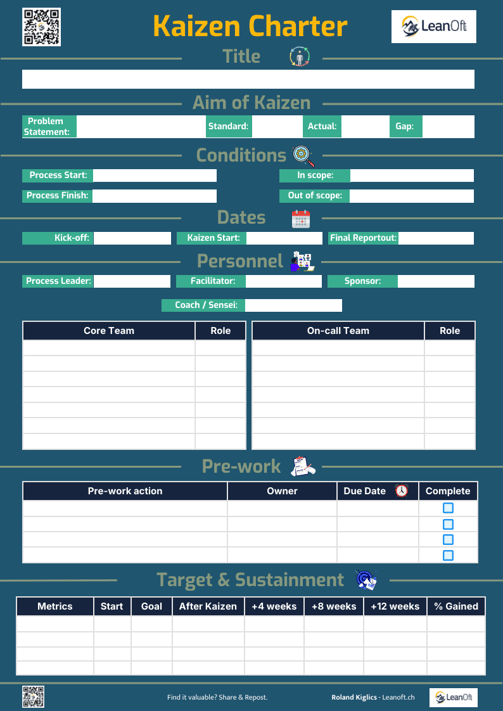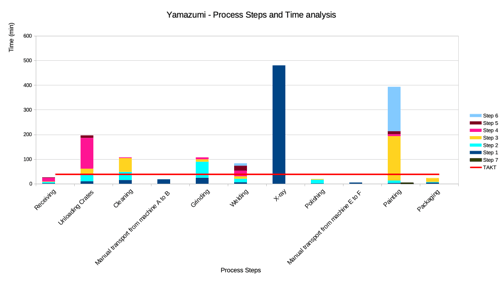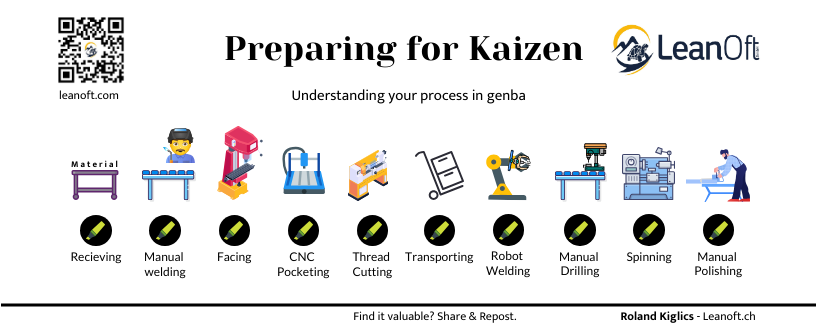How do you prepare for a Kaizen “week” or Kaizen “event”
The success of any Kaizen "event" depends largely on thorough preparation. Keeping the FOCUS on the specific problem at hand, involving the right people early and setting clear objectives can make all the difference. Remember, not every problem requires a Kaizen "event" - prioritise what really matters for impactful improvements!
CONTINUOUS IMPROVEMENTKAIZEN
Roland Kiglics
9/30/202412 min read
Introduction
In my first article "Starting with Kaizen: Kaizen vs. Kaizen “events” vs. Action Workouts", I established that Kaizen is not an event. Though a larger weeklong Kaizen, where multiple teams, each with 6-8 participants, could be done as a pre-scheduled “event” to make larger scale, strategic improvements or implement improvements that are more complex and too large for a 1-3 people small group to solve. Although Kaizen is not an event, a weeklong Kaizen can actually benefit any company in any industry.
In a follow-up article I described the "Key Elements of a Successful Kaizen", what a good Kaizen looks like and what you need to start your own first Kaizen “event”.
Now, I will continue focusing on these larger, week-long Kaizens. I will help you better understand what it takes to properly prepare for such a Kaizen.
Step zero – defining the focus of the Kaizen
Before we get into the details, the first step is to establish how something can become the focus of a large-scale, week-long kaizen 'event'.
Let’s have a high level look at how to select topics for your weeklong Kaizen “events”. Whether it is to build up your Kaizen Calendar or just to start where you are.
Look at your most important KPIs and see how they are compare to what you want them to be.
Ideally, your big Kaizens will either be linked to your Hoshin Kanri (business strategy), or you will be working on implementing a solution to a bigger problem you currently have in your business. Start with your most important area (value stream). A value stream is the collection of people and processes that exist to deliver value to the customer, whether it is by creating a product or providing some kind of service.
Example KPIs to check:
Safety:
Productivity / Quality:
Inventory:
Maintenance:
Customer Experience:
Many more KPIs could be listed… go through your KPIs and start where your pain-point currently is, establish current level, then start to improve.
Ask questions such as:
What actions do we need to take to get back on track?
How do we compare with our current standard?
What are our competitors doing better than us?
What are our problems (hopefully you have a way of recording everyday problems)?
Etc…
TRIR: Total Recordable Incident Rate
NMFR: Near Miss Frequency Rate
OTD: On-Time Delivery
COT: Changeover Time
PA: Production Attainment
TTA: Takt-time Attainment
FPY: First Pass Yield
SR: Scrap Rate
ITR: Inventory Turnover
ICC: Inventory Carrying Cost
SO: Stock-Outs
ED: Equipment Downtime
MTBR: Mean Time Between Repairs
Planned vs Non-Planned Maintenance
CSAT: Customer Satisfaction
ART: Average Resolution Time
OTD: On-Time Delivery (also a productivity KPI)
CRR: Customer Reject Rate
Are we winning or losing?
What does good look like?
What is our goal?
Are we on track to achieve our goals?
Typical focus areas for a Kaizen
Based on my experience of working with different types and sizes of companies, there are a few areas that are generally good to focus on if you don't know where to start:
Universally, for any business, focus Kaizen efforts on the biggest problem affecting many people daily in your main value stream, which often aligns with your strategic goals.
In animal care (hospitals and practices), focus on early patient discharge, cage turnaround, patient flow, customer satisfaction, triage processes, and daily management for maximum impact. Take a look at your inventory process and see how much material is expiring in your pharmacy.
Human hospitals, though different, benefit from similar focus areas: patient satisfaction, bed turnover, early release, patient flow, triage, expiring material cost, pharmacy processes and daily management.
For industrial settings (manufacturing, food, retail, laboratories, etc...) and office-based businesses (banks), concentrate on connecting operations, creating information and material flow, and reducing set-up times. Kaizen in office environments isn't just about organising and cleaning your desk; it involves optimizing information and task flow in computer systems, much like material flow in factories.
Pre-work for a Kaizen “event”
It is not the direct action part of Kaizen, but it certainly is an important part. Preparation for a large Kaizen "event" can take several weeks. I am not saying it is a full-time job for weeks on end. However, preparing for and running a successful week-long Kaizen will certainly take more time than most teams estimate. Depending on the size of the event, allow 2 to 10 weeks for thorough preparation.
As part of your annual roadmap of major Kaizens, the decision to run a week-long Kaizen 'event' should be made approximately 8-10 weeks before its scheduled date. For Hoshin Kanri related strategic Kaizens, cancellation should not be considered unless there has been a mid-year change in strategy. Similarly, if the Kaizen is aimed at solving a significant problem facing your team, it should never be cancelled. While rescheduling may be necessary if it conflicts with other priorities, outright cancellation sends the wrong message to the organisation and should be avoided at all costs.
This is especially important if the Kaizen is the result of an employee suggestion to improve something on a larger scale. If absolutely necessary, postpone it for a few weeks, but never cancel it altogether. Cancellations or unfulfilled promises are major factors in employee disengagement. People get tired of broken promises and eventually stop caring, which has a serious impact on organisational culture and productivity.
Decide whether or not the Kaizen is still a go




Create a Kaizen Charter
Creating a charter is beneficial because it puts important information in one place. A well-drafted charter should include the following elements:
Important note for the time-study:
You are dealing with people, they must understand why "they are" being measured. Although, you are not measuring the people but rather the process. You have to explain to people you are measuring the process and not them per say. It is very important to distinguish, otherwise you are losing supporters and your Lean / TPS efforts are dead from the get go. If you have a union, make sure you involve their leaders from the beginning and they must understand what and why something is being done. Ask them to get involved so they can see things first hand.
The Process Leader, Kaizen Team Lead, and Facilitator collaborate to create a Kaizen Week agenda calendar. This is distributed to interested parties by the Process Leader about two weeks before the event. The calendar outlines:
Define the problem you are trying to solve
A well-written problem statement is crucial. Unfortunately, many don't take the time or do not have the knowledge to formulate an effective one. Complaints such as "my tools are missing" or "we didn't deliver enough parts" are inadequate. To create a solid problem statement, follow the A3 problem-solving process and/or refer to KPIs and current standards.
Describes the current situation
Includes the relevant data (gap to standard)
Sets goals and timeline to achieve it
Current state Value Stream Map (VSM) – If needed, this must be created prior to the Kaizen “week”. This is a particularly long exercise and would take away the time from all the change implementation.
Workspace layout diagram – It could be done on paper or on a computer. But best, when this is actually something tangible. I have made this in the past using Lego or 3D printed elements, Cardboard, Foam sheets, etc… anything but make it to scale so you can use it to create a new layout that actually makes sense and works.
Collect all related current Standard Work documents – This includes Standard Work Combination Table, Leaders Standard Work, Standard Work Chart, Process Capability Sheet, Cycle time graph, etc...
Time-study sheet. This is a tricky one. Depending on the system, computer program and the way it is used, I sometimes rather collect it from scratch manually, than relying on data from a software where nobody can confirm whether that is accurate or not. (my general approach… trust but validate)
An effective problem statement should contain three key elements:
All relevant dates
Key personnel, as discussed in my previous post
Kaizen title: A concise description of the scope
Problem statement (see below)
Process boundary conditions: Start and end points of the process in scope
In-scope and out-of-scope elements
Target condition: Specific improvement goals
Key deliverables: Desired results of the Kaizen
Pre-Kaizen action list: Tasks to be completed before the 'event'
Sustainability plan: Detailing who, when, what, and how to ensure the change and new standards are maintained
The charter ensures that everyone is aligned on the goals, scope and expectations. It also provides a clear framework for measuring success and sustaining improvements over time.
This lets you understand the problem and make a straightforward statement without background details.
What does a good problem statement not have?
A solution
A proposed solution
Example 1:
The current patient triage process requires 3 different forms, each with 5-8 differently worded but otherwise identical questions, and takes an average of 20 minutes to complete with the assistance of two different nurses, resulting in a 30% increase in patient waiting times and a 25% decrease in patient satisfaction scores. Our goal is to streamline the triage process to reduce completion time to 3 minutes or less freeing up time for the nurses and improve patient satisfaction scores by 30% within 3 months.
Example 2:
Production line Alpha experiences an average of 5 unplanned downtimes per week, causing a 15% negative impact on our On-time-delivery. Our goal is to reduce unplanned downtimes to 0 per week, increasing production output by 10% to reach On-time-delivery of 92% by next quarter end.
Collect and analyse initial data
Your initial data requirements are greatly depend on the problem and the scope of the Kaizen. Blindly listing here everything would mean most people will stop reading if they have not done it already. :) However, to provide a guideline of what might be needed, I will list here some examples.
Create a Workload evaluation chart – aka – Yamazumi chart for each person/machine. Have your TAKT calculated. Identify Value Adding and Non-Value adding steps.
Create a Kaizen Target Sheet – this is your KPI based guide that shows where you are at the beginning of your Kaizen, where you want to be at the end and shows progress as you make changes during the Kaizen week.
Voice of Customer – input data. Anything you have from your customer that is related to the scope of your Kaizen.
Analyse both safety and financials – Involve EHS (safety personnel) and the finance manager or accountant from the start.
Note: Finance managers may need “extra lean training”, as lean finance differs from traditional methods. For more on this, read "Real Numbers - Management Accounting in a Lean Organisation" by Jean E. Cunningham and Orest J. Fiume. Fantastic Book on Lean finance.
Free Cash Flow (FCF) as % of Net Income – (supposed to go up)
Inventory Turns (IT) – (supposed to go up)
Accounts Receivable (AR) – (supposed to go down)
CAPEX and SG&A as % of Revenue – (supposed to go down)
Financing Cost (FC) – (supposed to go down)
Keep in mind the lagging nature of these KPIs. Knowing the key areas of focus to positively drive these metrics will help finance managers to approve the necessary funding for lean initiatives when required.
RACI – RACI Matrix is a simple tool that can be used in preparation to gain insight into the different roles and responsibilities of a process. The use of RACI becomes particularly important when dealing with a complex process. It helps to identify who should be on the team (roles with 'R' & 'A') or who should be on-call (roles with 'C') and roles with 'I' are the ones who are consulted during the pre-work as the customer of the process in focus.
Bonus:
When you are mapping, RACI can help you to identify the lanes where action takes place.
Agenda
Kaizen event dates
Daily activities (morning and afternoon)
Team progression guide throughout the week
The first day's agenda is particularly crucial. Involve Kaizen Team Leads in creating a detailed plan for this day to ensure teams start doing rather than planning from the beginning.
Identify Location
Kaizen events should always take place in the Genba, a Japanese term meaning "the real place" where value is created. It's crucial to be in the actual workplace because Kaizen is all about hands-on implementation of improvements. In a distant, cozy conference room, you can't see, touch, feel, change, or test your ideas effectively. This principle applies even for office Kaizen – you want to be in the office where the changes will occur.
For global teams working mostly online, I may sound old-school, but I still believe bringing the team together physically for Kaizen makes a lot of sense. It builds team cohesion, improves communication, and allows for a better "try, fail, and do it again" work environment. However, if physical gatherings aren't possible, modern technology can support online Kaizen, especially when improving processes that are already digital. Nevertheless, this is often not the best solution.
If you choose to conduct Kaizen online, the same rules apply as for in-person events, with one additional rule: cameras and microphones must be on at all times. This isn't about controlling participants, but ensuring 100% collaboration. When you're muted, you can't be heard; when you're off-camera, facial expressions and hand gestures are lost. These non-verbal cues are crucial for effective communication and shouldn't be overlooked.
Training
For participants new to Kaizen tools and techniques:
Provide training just before the event or after the kick-off meeting on day one
This ensures fresh knowledge that can be immediately applied
If training requires more than 1-2 hours, conduct it during the week prior, but not earlier
Classroom training alone is less effective; practical application in real-life situations is crucial, allowing the learners to put their fresh knowledge into practice in a real life situation.
Checklist
Use a preparation checklist to facilitate preparation and ensure completion. It is best to include it as part of the charter.
Important:
Avoid excessive paperwork to minimise bureaucracy. Kaizen is about hands-on improvement, not paperwork.
Finalize the Kaizen team
Put the team together. Read more information regarding the team in the previous “Key Elements of a Successful Kaizen” post.


When discussing finances regarding the Kaizen and / or the company’s lean/TPS efforts and their impact in general, good talking points usually include the following KPIs:
Occasionally it is good practice to have a goal that feels somewhat unattainable. I use the term unattainable deliberately, as what may feel challenging to some may easily feel unattainable to others. Either way, the aim is to get the team thinking 'out of the box' rather than going for the low hanging fruit that brings little or no benefit. If you want to change and be better, your traditional ways will not work. However, it is important to be clear about the objectives and to communicate them to everyone involved and affected by the Kaizen.
In the end, if they do not achieve the stretched target, it is still OK, as long as they have tried and achieved at least 50%+ of it, and have a clear plan for how to get the rest later with further Kaizens.
From a pure numbers perspective: Imagine the goal is to reduce the changeover time of a machine from your current 8 hours to under 10 minutes. This may seem impossible and your team will think you are crazy, but think about it for a second. If they try and 'fail' by only achieving a 50% reduction, it is still a win. Instead of losing a whole shift to changeover, you now only lose half a day of valuable operating time. 10% loss compared to 20% before. If you gave them a comfortable 20-30% reduction target and they achieved it, you would still lose the majority of the shift to changeover. The key here is to understand where to use this technique and where to set clear and non-negotiable targets. It is not as if you communicate in advance that it is OK for them to miss the target, but be realistic but stretch the team to make progress. Again, NO blame. Look at the big picture and communicate accordingly.
One extra note on target settings
Kaizen 1 target: 4 hours,
Kaizen 2 target: 2 hours,
Kaizen 3 target: 10 minutes.
Alternatively, depending on the maturity of the Kaizen culture, you could start by setting not just targets, but milestones. Staying with the example above, you know you want to get to a changeover time of less than 10 minutes (ideally less than or equal to the TAKT time), but right now from 8 hours it seems really unattainable. In order not to break the team spirit, you should start 'small' to build momentum, you could set staged targets such as:
The success of a Kaizen “event” depends significantly on thorough preparation. During the pre-work phase, keep one word in mind: FOCUS. Concentrate on the specific problem you aim to solve and gather relevant information. It's crucial to involve the right people early in the process to ensure their insights contribute effectively. Remember, not every problem requires a Kaizen “event”; it's essential to set precise goals, define the scope with clear boundary conditions, and formulate a well-defined problem statement based on collected data. Achieving these elements is already half the battle won before the Kaizen “event” begins.
Conclusion
Next Steps
In my next post I look at how a Kaizen 'event' is run. Please click here to read more.
Further reading
Bob Emiliani, Katsusaburo Yoshino, Rudy Go (2015). Kaizen Forever: Teachings of Chihiro Nakao. Wethersfield, Connecticut, USA: CLBM, LLC.
Barney Art (2017). The Lean Turnaround Action Guide: How to Implement Lean, Create Value, and Grow Your People. New York, USA: McGraw-Hill.
“Ask Art: What Was Danaher Like In the Early Days of Lean?” By Barney, Art, 17 September 2020
Jean E. Cunningham, Orest Fiume, Emily Adams (2003). Real Numbers: Management Accounting in a Lean Organisation. Boston, MA 02210 USA: Lean Enterprise Institute, Inc.
Video to watch
“Exploring the gaps in people’s understanding of Kaizen” by Emiliani Bob, (2024)
Book Your First Consultation
Get in touch to discuss how LeanOft can help you today.
Get to know us
Do you prefer personal contact over a form? Take the opportunity and write an email to get to know LeanOft and the people behind it.
Quick and Direct Access
Give us a call:
+41779456508
LeanOft GmbH provides hands-on, People-Centered Lean implementation support and problem solving for organizations that want to be better tomorrow than they are today.
LeanOft GmbH is primarily based in Switzerland and is working with companies in Switzerland and in Europe
Follow us
COPYRIGHT © 2025 LeanOft GmbH


+41779456508


